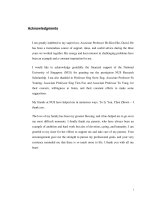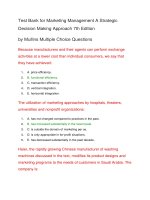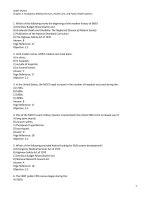Business statistics a decision making approach 6th edition ch12ppln
Bạn đang xem bản rút gọn của tài liệu. Xem và tải ngay bản đầy đủ của tài liệu tại đây (142.17 KB, 26 trang )
Business Statistics:
A Decision-Making Approach
6th Edition
Chapter 12
Goodness-of-Fit Tests and
Contingency Analysis
Business Statistics: A Decision-Making Approach, 6e © 2010 PrenticeHall, Inc.
Chap 12-1
Chapter Goals
After completing this chapter, you should be
able to:
Use the chi-square goodness-of-fit test to
determine whether data fits a specified distribution
Set up a contingency analysis table and perform a
chi-square test of independence
Business Statistics: A Decision-Making Approach, 6e © 2010 PrenticeHall, Inc.
Chap 12-2
Chi-Square Goodness-of-Fit
Test
Does sample data conform to a hypothesized
distribution?
Examples:
Are technical support calls equal across all
days of the week? (i.e., do calls follow a
uniform distribution?)
Do measurements from a production
process follow a normal distribution?
Business Statistics: A Decision-Making Approach, 6e © 2010 PrenticeHall, Inc.
Chap 12-3
Chi-Square Goodness-of-Fit
Test
(continue
d) the
Are technical support calls equal across all days of
week? (i.e., do calls follow a uniform distribution?)
Sample data for 10 days per day of week:
Sum of calls for this day:
Monday
Tuesday
Wednesday
Thursday
Friday
Saturday
Sunday
290
250
238
257
265
230
192
= 1722
Business Statistics: A Decision-Making Approach, 6e © 2010 PrenticeHall, Inc.
Chap 12-4
Logic of Goodness-of-Fit Test
If calls are uniformly distributed, the 1722 calls
would be expected to be equally divided across
the 7 days:
1722
246 expected calls per day if uniform
7
Chi-Square Goodness-of-Fit Test: test to see if
the sample results are consistent with the
expected results
Business Statistics: A Decision-Making Approach, 6e © 2010 PrenticeHall, Inc.
Chap 12-5
Observed vs. Expected
Frequencies
Observed
oi
Expected
ei
Monday
Tuesday
Wednesday
Thursday
Friday
Saturday
Sunday
290
250
238
257
265
230
192
246
246
246
246
246
246
246
TOTAL
1722
1722
Business Statistics: A Decision-Making Approach, 6e © 2010 PrenticeHall, Inc.
Chap 12-6
Chi-Square Test Statistic
H0: The distribution of calls is uniform
over days of the week
HA: The distribution of calls is not uniform
The test statistic is
(oi ei )
ei
2
2
(where df k 1)
where:
k = number of categories
oi = observed cell frequency for category i
ei = expected cell frequency for category i
Business Statistics: A Decision-Making Approach, 6e © 2010 PrenticeHall, Inc.
Chap 12-7
The Rejection Region
H0: The distribution of calls is uniform
over days of the week
HA: The distribution of calls is not uniform
2
(
o
e
)
i
2 i
ei
Reject H0 if
2
(with k – 1 degrees
of freedom)
2
α
0
Business Statistics: A Decision-Making Approach, 6e © 2010 PrenticeHall, Inc.
2
Do not
reject H0
2
Reject H0
Chap 12-8
Chi-Square Test Statistic
H0: The distribution of calls is uniform
over days of the week
HA: The distribution of calls is not uniform
2
2
2
(290
246)
(250
246)
(192
246)
2
...
23.05
246
246
246
k – 1 = 6 (7 days of the week) so
use 6 degrees of freedom:
2.05 = 12.5916
Conclusion:
2 = 23.05 > 2 = 12.5916 so
reject H0 and conclude that the
distribution is not uniform
= .05
0
Business Statistics: A Decision-Making Approach, 6e © 2010 PrenticeHall, Inc.
Do not
reject H0
Reject H0
2.05 = 12.5916
2
Chap 12-9
Normal Distribution Example
Do measurements from a production process
follow a normal distribution with μ = 50 and σ
= 15?
Process:
Get sample data
Group sample results into classes (cells)
(Expected cell frequency must be at least
5 for each cell)
Compare actual cell frequencies with expected
cell frequencies
Business Statistics: A Decision-Making Approach, 6e © 2010 PrenticeHall, Inc.
Chap 12-10
Normal Distribution Example
Sample data and values grouped into classes:
150 Sample
Measurements
80
65
36
66
50
38
57
77
59
…etc…
Business Statistics: A Decision-Making Approach, 6e © 2010 PrenticeHall, Inc.
•Class
•
•Frequency
•less than 30
•10
•30 but < 40
•21
•40 but < 50
•33
•50 but < 60
•41
•60 but < 70
•26
•70 but < 80
•10
•80 but < 90
•7
•90 or over
•2
TOTAL
(continue
d)
150
Chap 12-11
Normal Distribution Example
What are the expected frequencies for these
a normal distribution with μ = 50 and σ = 15?
•Class
•
•Frequency
•less than 30
•10
•30 but < 40
•21
•40 but < 50
•33
•50 but < 60
•41
•60 but < 70
•26
•70 but < 80
•10
•80 but < 90
•7
•90 or over
•2
TOTAL
150
Business Statistics: A Decision-Making Approach, 6e © 2010 PrenticeHall, Inc.
(continue
d) for
classes
•Expected
Frequency
•?
Chap 12-12
Expected Frequencies
•Value
•
•P(X < value)
•Expected
•frequency
•less than 30
•0.09121
•13.68
•30 but < 40
•0.16128
•24.19
•40 but < 50
•0.24751
•37.13
•50 but < 60
•0.24751
•37.13
•60 but < 70
•0.16128
•24.19
Expected
frequencies in a
sample of size n=150,
from a normal
distribution with
μ=50, σ=15
Example: 30 50
P(x 30) P z
15
•70 but < 80
•0.06846
•10.27
•80 but < 90
•0.01892
•2.84
P(z 1.3333)
•90 or over
•0.00383
•0.57
.0912
TOTAL
•1.00000
150.00
Business Statistics: A Decision-Making Approach, 6e © 2010 PrenticeHall, Inc.
(.0912)(150) 13.68
Chap 12-13
The Test Statistic
•Class
•(observed, oi)
•Expected
Frequency, ei
•less than 30
•10
•13.68
•30 but < 40
•21
•24.19
•40 but < 50
•33
•37.13
•50 but < 60
•41
•37.13
•60 but < 70
•26
•24.19
•70 but < 80
•10
•10.27
•80 but < 90
•7
•2.84
•90 or over
•2
•0.57
150
150.00
•Frequency
•
TOTAL
Business Statistics: A Decision-Making Approach, 6e © 2010 PrenticeHall, Inc.
The test statistic is
2
(
o
e
)
i
2 i
ei
Reject H0 if
2
2
α
(with k – 1 degrees
of freedom)
Chap 12-14
The Rejection Region
H0: The distribution of values is normal
with μ = 50 and σ = 15
HA: The distribution of calls does not
have this distribution
(oi ei )2 (10 13.68 )2
(2 0.57 )2
2
...
12.097
ei
13.68
0.57
8 classes so use 7 d.f.:
2.05 = 14.0671
Conclusion:
2 = 12.097 < 2 = 14.0671 so
do not reject H0
=.05
0
Business Statistics: A Decision-Making Approach, 6e © 2010 PrenticeHall, Inc.
2
Do not
reject H0
Reject H0
2.05 = 14.0671
Chap 12-15
Contingency Tables
Contingency Tables
Situations involving multiple population
proportions
Used to classify sample observations according
to two or more characteristics
Also called a crosstabulation table.
Business Statistics: A Decision-Making Approach, 6e © 2010 PrenticeHall, Inc.
Chap 12-16
Contingency Table Example
Left-Handed vs. Gender
Dominant Hand: Left vs. Right
Gender: Male vs. Female
H0: Hand preference is independent of gender
HA: Hand preference is not independent of gender
Business Statistics: A Decision-Making Approach, 6e © 2010 PrenticeHall, Inc.
Chap 12-17
Contingency Table Example
(continue
d)
Sample results organized in a contingency table:
Hand Preference
sample size = n = 300:
120 Females, 12
were left handed
180 Males, 24 were
left handed
Gender
Left
Right
Female
12
108
120
Male
24
156
180
36
264
300
Business Statistics: A Decision-Making Approach, 6e © 2010 PrenticeHall, Inc.
Chap 12-18
Logic of the Test
H0: Hand preference is independent of gender
HA: Hand preference is not independent of gender
If H0 is true, then the proportion of left-handed females
should be the same as the proportion of left-handed
males
The two proportions above should be the same as the
proportion of left-handed people overall
Business Statistics: A Decision-Making Approach, 6e © 2010 PrenticeHall, Inc.
Chap 12-19
Finding Expected
Frequencies
120 Females, 12
were left handed
Overall:
180 Males, 24 were
left handed
P(Left Handed)
= 36/300 = .12
If independent, then
P(Left Handed | Female) = P(Left Handed | Male) = .12
So we would expect 12% of the 120 females and 12% of the 180
males to be left handed…
i.e., we would expect (120)(.12) = 14.4 females to be left handed
(180)(.12) = 21.6 males to be left handed
Business Statistics: A Decision-Making Approach, 6e © 2010 PrenticeHall, Inc.
Chap 12-20
Expected Cell Frequencies
Expected cell frequencies:
th
(continue
d)
th
(i Row total)( j Column total)
eij
Total sample size
Example:
(120 )(36 )
e11
14.4
300
Business Statistics: A Decision-Making Approach, 6e © 2010 PrenticeHall, Inc.
Chap 12-21
Observed v. Expected
Frequencies
Observed frequencies vs. expected frequencies:
Hand Preference
Gender
Left
Right
Female
Observed = 12
Expected = 14.4
Observed = 108
Expected = 105.6
120
Male
Observed = 24
Expected = 21.6
Observed = 156
Expected = 158.4
180
36
264
300
Business Statistics: A Decision-Making Approach, 6e © 2010 PrenticeHall, Inc.
Chap 12-22
The Chi-Square Test Statistic
The Chi-square contingency test statistic is:
2
r
c
i1 j 1
(oij eij )2
eij
with
d.f . (r 1)(c 1)
where:
oij = observed frequency in cell (i, j)
eij = expected frequency in cell (i, j)
r = number of rows
c = number of columns
Business Statistics: A Decision-Making Approach, 6e © 2010 PrenticeHall, Inc.
Chap 12-23
Observed v. Expected
Frequencies
Hand Preference
Gender
Left
Right
Female
Observed = 12
Expected = 14.4
Observed = 108
Expected = 105.6
120
Male
Observed = 24
Expected = 21.6
Observed = 156
Expected = 158.4
180
36
264
300
(12 14.4)2 (108 105.6)2 (24 21.6)2 (156 158.4)2
0.6848
14.4
105.6
21.6
158.4
2
Business Statistics: A Decision-Making Approach, 6e © 2010 PrenticeHall, Inc.
Chap 12-24
Contingency Analysis
2 0.6848
with d.f. (r - 1)(c - 1) (1)(1) 1
Decision Rule:
If 2 > 3.841, reject H0,
otherwise, do not reject H0
= 0.05
2.05 = 3.841
Do not reject H0
Reject H0
Business Statistics: A Decision-Making Approach, 6e © 2010 PrenticeHall, Inc.
2
Here, 2 = 0.6848
< 3.841, so we
do not reject H0
and conclude that
gender and hand
preference are
independent
Chap 12-25









